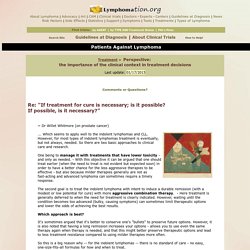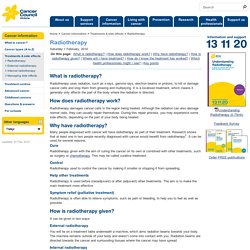

EviQ Cancer Treatments Online > eviQ home. Clinical Context. ~ Dr Willet Whitmore (on prostate cancer) ...

Which seems to apply well to the indolent lymphomas and CLL. However, for most types of indolent lymphomas treatment is eventually, but not always, needed. So there are two basic approaches to clinical care and research. One being to manage it with treatments that have lower toxicity - and only as needed. - With this objective it can be argued that one should treat earlier (when the need to treat is not evident but expected soon) in order to have a better chance for the less aggressive therapies to be effective - but also because milder therapies generally are not as fast-acting and advanced lymphoma can sometimes require a timely response.The second goal is to treat the indolent lymphoma with intent to induce a durable remission (with a modest or low potential for cure) with more aggressive combination therapy. - Here treatment is generally deferred to when the need for treatment is clearly indicated.
Watchful Waiting and Monitoring Indolent Lymphomas. When you have an indolent (slow growing) lymphoma that is not causing symptoms (such as fatigue) or is not putting you in danger, your doctor might recommend watchful waiting, even when the disease is at an advanced stage.

One reason your doctor might recommend observation is that the indolent lymphomas can remain stable for long periods of time, and sometimes regress spontaneously. In other words, your quality of life can be very good when you have an advanced indolent lymphoma and there is no proven advantage in the long term to treating an indolent lymphoma as soon as possible. Further, there have been case reports of indolent lymphomas remaining stable for as long as twenty years, but it should be noted that most patients will receive first treatment within 1 to 3 years after diagnosis. "For all 44 "deferred" patients, the median time before requiring treatment was 31 months, and there have been 19 patients who have not yet required therapy for periods of 3 to 104 months. " 1. Factors that Influence Treatment Decisions.
TOPICS Factors | When?

| Which? | Goal of Treatment? | Big Picture Questions * Oncology Times 2013:View from the Other Side of the Stethoscope: Distressing Decisions "Faith. Gut feeling. TOPIC SEARCH: PubMed There are many factors that influence treatments decisions, particularly for patients with indolent lymphomas. Factors that can influence the timing and choice of therapy - the clinical context The following table illustrates the complexity of the clinical context - how each case and lymphoma can be unique. What is the most appropriate goal of treatment? Is it to achieve a durable remission with potential to cure? Regarding Tradeoffs Virtually every treatment approach has potential tradeoffs: An aggressive therapy might give a better chance for a complete and more durable remission (or cure), but can have greater toxicities in the short or long term. The Challenge of indolent disease: The clinical course of the follicular (and other indolent) lymphomas can be quite variable.
Dr. Understanding Radiotherapy. What is Radiotherapy? - Cancer Council Victoria. Saturday 1 February, 2014 On this page: What is radiotherapy?

| How does radiotherapy work? | Why have radiotherapy? | How is radiotherapy given? | Where will I have treatment? What is radiotherapy? Radiotherapy uses radiation, such as x-rays, gamma rays, electron beams or protons, to kill or damage cancer cells and stop them from growing and multiplying. How does radiotherapy work? Radiotherapy damages cancer cells in the region being treated. Why have radiotherapy? Many people diagnosed with cancer will have radiotherapy as part of their treatment. Cure Radiotherapy given with the aim of curing the cancer on its own or combined with other treatments, such as surgery or chemotherapy. Control Radiotherapy used to control the cancer by making it smaller or stopping it from spreading. Cancer treatments - radiotherapy - Better Health Channel.
Chemotherapy Regimens - Cancer Therapy Advisor. Cancer therapy selection, dosing, administration, and the management of related adverse events can be a complex process that should be handled by an experienced healthcare team.

Clinicians must choose and verify treatment options based on the individual patient; drug dose modifications and supportive care interventions should be administered accordingly. The cancer treatment regimens below may include both U.S. Food and Drug Administration-approved and unapproved indications/regimens. These regimens are only provided to supplement the latest treatment strategies. These Guidelines are a work in progress that may be refined as often as new significant data becomes available.